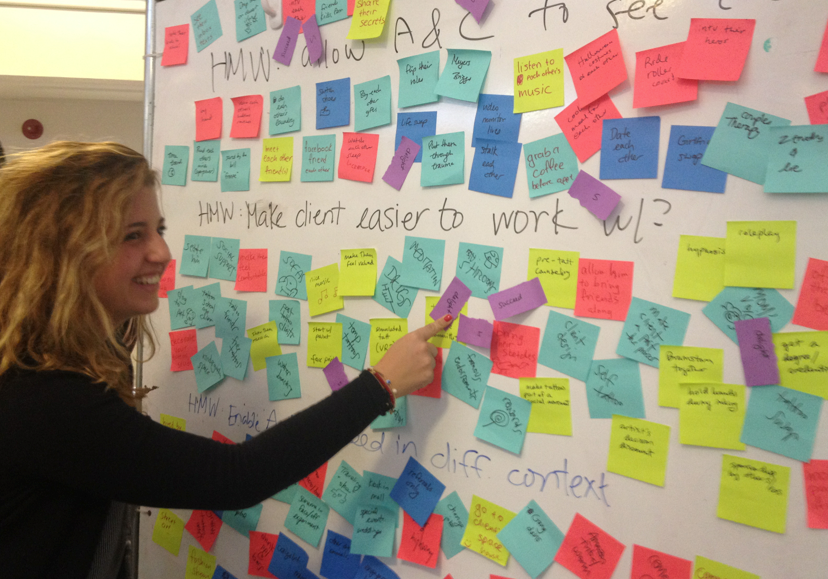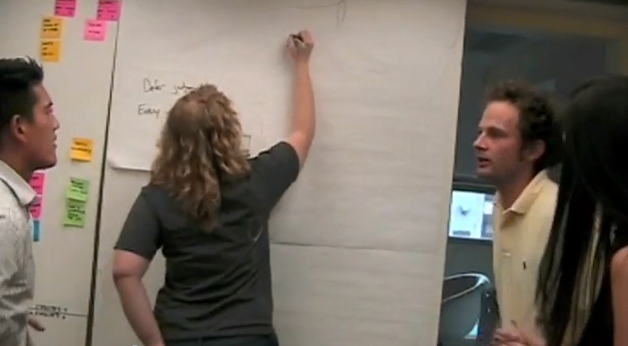Design Phase:
Ideate
It's time to make the leap from problem to solution.
Ideation is the process of generating ideas. Ideation, at its core, is about getting your inner critic out of the way so that your creativity can burst through and make magic. Ideation isn't just that "eureka" moment when the solution occurs to you. It's also the hundred other ideas you don't pursue. Good ideas, stupid ideas, crazy ideas, expensive ideas, impossible ideas – all of them are fair game in this phase.
If you have a flash of inspiration in the shower, are you ideating? Absolutely. If a crazy idea strikes you while you're making dinner, is that ideation? Sure thing. So why bother teaching something we all know how to do already?
What we'll cover are ways to spark those lightning strikes. They don't always happen on command. Knowing how to deliver a hefty jolt to your right brain will make you a more nimble generator of ideas – and help you be "creative" even when you're not feeling it.
Brainstorming: generating many radical, creative ideas
We have all heard the term “brainstorming,” but what is it really and why do we use it? This article will answer these questions and help you to get the best ideas out of your brainstorming sessions.Do you want to be incremental or radical?
Bob Litan of the Kauffman Foundation lays out the difference between the logical next step and the next earth-shaking thing.
Hell, there are no rules here. We're trying to accomplish something.Thomas Edison
Ideation is the process of idea generation. Mentally it represents a process of “going wide” in terms of concepts and outcomes, expanding the set of possible solutions.
Ideation provides the fuel for building prototypes and driving innovative solutions. It’s about giving your creativity and intuition free rein in order to solve the need you found in the last phase.
At the end of a good ideation session, you’ll have discovered some obvious solutions and some obscure ones. Some ideas will be brilliant, some will be half-baked, and some will be so crazy they just might work!
Eight brainstorming rules
Adam from the Stanford d.school leads a group brainstorm, showing his top ways to keep the brainstorm productive and fun.
No group? No problem
Many people find – and research shows – that generating ideas on your own can be just as productive as working in a group. Here's a suggested workflow for getting in your zone.
Bodystorming: get kinetic
Try actually walking through an experience to use a different part of your brain. Here is a guide from the d.school bootleg for using your space and your body to trigger new connections and ideas.If you want to have good ideas you must have many ideas. Most of them will be wrong, and what you have to learn is which ones to throw away.Linus Pauling
More resources

Pick a POV.
Remember the POV video you made? This user is the person whose problem you’re going to work on solving. During the challenge, we encouraged people to view others' POV videos, so if you're working with others, now is a great time to share your progress.
Get out of your chair.
Shake out your shoulders, bust out some jazz hands. Do a couple jumping jacks (or Burpees if you’re hardcore).
Set your space (and a timer).
Get some blank paper and something to write with. Set a timer for 10 minutes.
Sketch your ideas.
Write the user’s problem at the top of a blank page, then sketch at least 10 ways to solve that problem. Go for quantity, not quality.
Molly, our lead designer, even made you a playlist. Go ahead, rock out.

Refine one idea into a possible solution.
Look over your sketches. Which one is a diamond in the rough? Create a quick video explaining that solution concept.If you're having a tough time deciding which idea to refine, you might consider:
- Which idea would most excite the person you interviewed?
- Which idea is so obvious you are shocked it doesn't already exist?
- Which idea are you most excited to work on?
- Which idea seems crazy but could be a total breakthrough?





